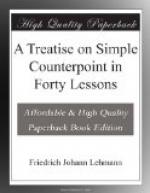[Illustration: Fig. 104.]
The cadences in Fig. 105 are good, and will suggest others. Those with first species in all parts may also be used.
[Illustration: Fig. 105.]
EXERCISES
To cantus firmus a write a counterpoint in the second species in one part. Write three settings, as directed in the previous lesson.
Write two eight-measure phrases mixing the first and second species in all parts.
To cantus firmus b write counterpoints in the second species in the other two parts. Write two settings, with the cantus firmus in different parts.
CANTI FIRMI
[Illustration: Fig. 106.]
LESSON XIV
THIRD SPECIES
[Illustration: Fig. 107.]
The suggestions for third species in two-part counterpoint, as well as those for writing the second species in three-part counterpoint, apply when writing third species in three-part counterpoint.
The cadences at Fig. 108 are good, and will suggest others.
[Illustration: Fig. 108.]
EXERCISES
To cantus firmus a write third species in one part. Write three settings as previously directed.
To cantus firmus b write second species in two parts, as previously directed.
Write one eight-measure phrase, using second species in all parts.
CANTI FIRMI
[Illustration: Fig. 109.]
LESSON XV
THIRD SPECIES IN TWO OR MORE PARTS
[Illustration: Fig. 110.]
Previous suggestions when two or more parts have other than first species, apply here.
In using the ninth of a chord it is well to keep it at least a seventh distant from the third, as well as a ninth above the root, except in the case of the dominant ninth in minor keys, where it may be separated by only an augmented second ([b]). [Fig. 111.]
[Illustration: Fig. 111.]
In writing the third species in all parts, notes appearing simultaneously should be harmonically related. Treat all tones foreign to the chord on the first quarter as dissonances.
The cadences in Fig. 112 are good.
[Illustration: Fig. 112.]
EXERCISES
To cantus firmus a write third species in one part, as previously directed.
To cantus firmus b write third species in two parts, as in Fig. 110_b_. Write twice, changing the cantus firmus about.
Write one eight-measure phrase, mixing first and third species as in Fig. 110_a_.




